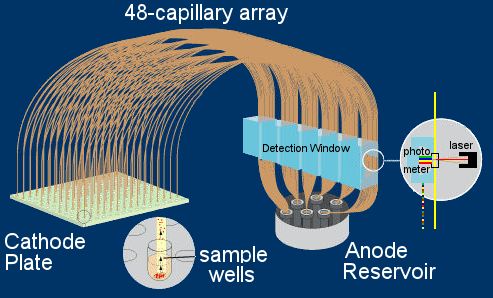

Capillary DNA sequencing
Separation of DNA products from a DNA
sequencing reaction by conventional gel
electrophoresis creates a number of challeneges,
including preparing gels, practical problems of loading
multiple reactions manually in a single gel,
differential migration rates of products across the
width of the gel, and long electrophoresis times (8 ~12
hrs for long fragments). An alternative separation
method uses (A) ultra-thin capillaries,
pre-packed with a a gel-like matrix material. (B)
Because of the extremeley high voltage applied,
electrophoretic separation occurs in a few hours, and,
unlike gel electrophoresis, the capillary matrix can be
reused multiple times. [Right] Fragment mobilities in
sets of eight capillaries are monitored simultaneously
at an immobile detector window, so that the
order in which succesively longer fragments pass the
detector automatically determines the sequence.
A capillary array includes 48~96 capillaries that are loaded automatically by a robot from a stack of 96-well reaction plates, renewed as required, so that sequencers can be run continuously. Sequence data (chromatograms) are fed directly to a central computer server, and may be downloaded remotely at labs hundreds or thousands of kilometers from the facility. Large-scale sequencing laboratories such as those used in the Human Genome Project may have dozens or hundreds of machines operating 24-7. Economies of scale may make it cheaper to out-source DNA sequencing to such a facility than to purchase, maintain, and staff a DNA sequencer locally.
A capillary array includes 48~96 capillaries that are loaded automatically by a robot from a stack of 96-well reaction plates, renewed as required, so that sequencers can be run continuously. Sequence data (chromatograms) are fed directly to a central computer server, and may be downloaded remotely at labs hundreds or thousands of kilometers from the facility. Large-scale sequencing laboratories such as those used in the Human Genome Project may have dozens or hundreds of machines operating 24-7. Economies of scale may make it cheaper to out-source DNA sequencing to such a facility than to purchase, maintain, and staff a DNA sequencer locally.
Figure after © 2012 TA Brown, Introduction
to Genetics (1st ed.); additional
text © 2015 by Steven M. Carr